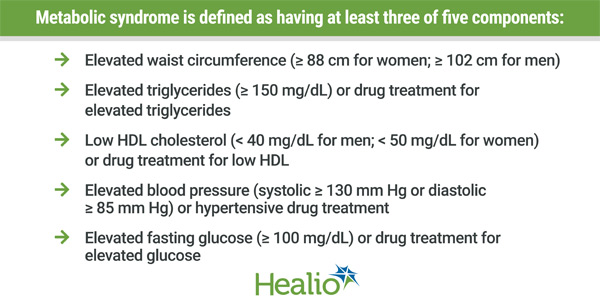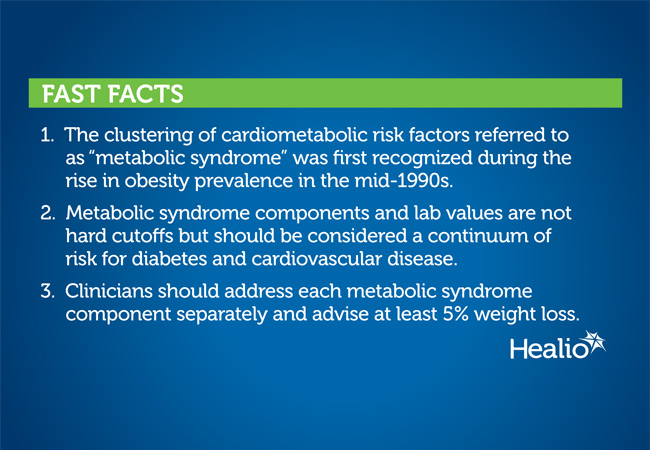‘Metabolic syndrome’ label imprecise, but cardiometabolic risk is real
The term “metabolic syndrome” has been used since the mid-1990s to describe a constellation of risk factors that predispose adults to develop diabetes, cardiovascular disease or both. These factors, many of which are linked to obesity, inactivity and unhealthy diet, appear to be emerging among younger patients. From 1988-1994 to 2007-2012, the prevalence of metabolic syndrome among U.S. adults rose by more than 35%, from 25.3% to 34.2%, according to the CDC.
Metabolic syndrome, which can include abdominal girth, elevated triglycerides or blood pressure, low HDL cholesterol or glucose abnormalities, quintuples risk for developing type 2 diabetes and doubles risk for developing CVD in the 5 to 10 years after diagnosis, according to the International Diabetes Federation (IDF). Adults with components of metabolic syndrome are twice as likely to die of a CV event as those without the syndrome, regardless of a previous history of CVD.
“Metabolic syndrome is a term we use to describe several entities that, at times individually, but more often when combined together, raise the risk for developing serious conditions — specifically, CVD, both coronary artery and peripheral vascular disease, stroke and type 2 diabetes,” Valentina Rodriguez, MD, assistant professor of clinical medicine in the division of endocrinology, diabetes and metabolism at the University of Miami Miller School of Medicine, told Endocrine Today. “Type 2 diabetes is also, in turn, considered a CVD risk equivalent. These two conditions are very serious because they raise risk for death, so we should consider metabolic syndrome a serious precursor or warning sign of CVD and diabetes.”
Despite such warnings, disagreement persists among international health groups about what specifically constitutes metabolic syndrome. In a 2009 consensus statement published in Circulation, six major associations, led by the IDF, endorsed harmonized criteria to more accurately define the syndrome, but clinicians and researchers continue to question what the label should mean for patients who receive a metabolic syndrome diagnosis.

Photo by Jason Torres. Printed with permission.
Some experts contend that metabolic syndrome is not a “syndrome” at all.
“Metabolic syndrome is such an abstract concept,” Savitha Subramanian, MD, associate professor in the division of metabolism, endocrinology and nutrition and medical director of the Lipid Clinic at the University of Washington School of Medicine, told Endocrine Today. “It is not really a syndrome. One should think about it as a clustering of risk factors, which is how I explain it to students and residents and trainees who come through my clinic. Controversy still exists about this term.”
Meredith A. Hawkins, MD, professor of endocrinology, the Harold and Muriel Block Chair in Medicine and director of the Global Diabetes Institute at Albert Einstein College of Medicine, said she has watched the evolution of the condition and pointed to an “ever growing list” of risk factors that could potentially be placed under the metabolic syndrome umbrella.
“When I was doing my training in endocrinology, it was around that time that the metabolic syndrome, or syndrome X, was revolutionary and coincided with a very real increase in obesity prevalence,” Hawkins told Endocrine Today. “It is very difficult to define. We could define it as a cluster or a constellation of cardiovascular risk factors. The bottom line is, regardless of those who prefer it be called a ‘syndrome’ or not, there is generally tight agreement on the fact that there is a clustering of these risk factors. The problem is that it has been very difficult to find the root cause for why these diverse manifestations would in fact cluster together.”
History, controversies
Complicating efforts to better understand the public health burden of metabolic syndrome and identify prevention strategies is the lack of consistency in the clinical definition and categorical cut points for component conditions.
The current concept of metabolic syndrome was articulated by Gerald Reaven, MD, in 1988 when he used “syndrome X” to describe a cluster of metabolic abnormalities: hypertension, dyslipidemia and hyperglycemia. He held that this was not a chance clustering, but related to insulin resistance and hyperinsulinemia — a syndrome that could predict people at risk for diabetes and CVD.
By the late 1990s, several expert groups developed criteria for metabolic syndrome, including WHO and the European Group for the Study of Insulin Resistance. The clinical definition most widely used in the United States was from the National Cholesterol Education Program – Adult Treatment Panel III (NCEP ATP III) introduced in the early 2000s. All groups agreed on the core components of metabolic syndrome: obesity, insulin resistance, dyslipidemia, hyperglycemia and hypertension. However, differences in definitions — particularly those for obesity and hyperglycemia — yielded conflicting results when attempting to identify individuals with metabolic syndrome in clinical practice, according to Yehuda Handelsman, MD, FACP, FNLA, FASCP, MACE, medical director and principal investigator of the Metabolic Institute of America in Tarzana, California.
“Over the years, we gave this syndrome many different names,” Handelsman, also an Endocrine Today Editorial Board Member, said in an interview. “I was part of the AACE consensus group that chose to call it the ‘insulin resistance syndrome.’ Gerald Reaven and I maintained that people do not need to be obese to have insulin resistance and metabolic syndrome. Other groups said no, obesity must be part of the criteria.”
Today, the IDF identifies a person as having metabolic syndrome if they have central obesity, defined as an increased waist circumference with ethnicity-specific values, plus any two of the following four factors: triglyceride level of at least 150 mg/dL; HDL cholesterol level of less than 40 mg/dL for men and less than 50 mg/dL for women; systolic BP of at least 130 mm Hg or diastolic BP of at least 85 mm Hg; and a fasting plasma glucose of at least 100 mg/dL.

According to the ATP III criteria, although abdominal obesity is a component of the syndrome, it is not a prerequisite for its diagnosis. Any three components of the five will make the diagnosis. That distinction leads to a change in prevalence estimates depending on the criteria used, according to researchers.
“By using the definition of metabolic syndrome from the International Diabetes Federation and the National Cholesterol Education Program, the prevalence of metabolic syndrome is estimated at more than 30% in the United States; however, by using the Adult Treatment Panel criteria, prevalence is estimated at about 22%,” Justin Xavier Moore, MPH, a predoctoral fellow in the department of epidemiology at the University of Alabama at Birmingham, and colleagues wrote in the March 2017 issue of Preventing Chronic Disease.
Debate also continues regarding whether a defined number of risk factors confers greater risk for developing a CVD and diabetes than the individual components do, according to Peter W.F. Wilson, MD, an Endocrine Today Editorial Board Member, professor of medicine in the division of cardiology at Emory University School of Medicine, professor of public health in the Rollins School of Public Health at Emory University, and director of epidemiology and genomic medicine at the Atlanta VA Medical Center.
“The syndrome itself is defined as three out of five elements, so now you’re getting into poker,” Wilson told Endocrine Today. “The discussion with the patient is essentially, ‘What does my hand look like?’ In an analysis my colleagues and I did when I was participating in the Framingham Heart Study, we found that two out of five risk factors conferred about the same risk as three out of five. Each of the individual risk factors conferred about a 50% increased risk for developing diabetes over time, or CVD, but there’s nothing magical about two out of five or three out of five. Each risk factor increases the risk for diabetes, and each one also increases the risk for heart disease.”
At the same time, the criteria omit other key risk factors clinicians should consider for CVD and type 2 diabetes, Rodriguez said, namely, family history, physical activity, smoking, alcohol use and other inflammatory conditions, such as rheumatoid arthritis and thyroid disease, which confer their own independent risks for CVD.

Similarly, cutoff values for the individual risk factors — for example, a fasting glucose of 100 mg/dL or greater — should not be looked at as defining lines, Rodriguez said.
“These cutoffs exist because, to create a definition, we need a cutoff,” Rodriguez said. “I would argue that you always need to look at this as a continuum. If a patient has increased belly fat and their fasting glucose is 99 mg/dL and their BP is 134/84 mm Hg, they may not exactly meet the defined criteria for metabolic syndrome, but they are very close to it. That doesn’t mean you don’t have metabolic syndrome and your CV risk is not as great. What it means is we still have to be proactive about preventive care and discuss this again in the near future.”
Risk picture
According to the consensus worldwide definition of metabolic syndrome, the clustering of risk factors is now considered to be “the driving force for a new CVD epidemic.”
“Increased waist circumference, what we call atherogenic dyslipidemia, or slightly elevated BP, all of these are a reflection of your CV risk down the road as you get older,” Subramanian said. “These risks are precursors or markers for developing diabetes or hypertension, because it is still early. One could think of them as prehypertension or prediabetes. That’s the implication.”
In a study published in November in Annals of Internal Medicine, researchers found that patients who recovered from metabolic syndrome decreased their risk for major adverse CV events, whereas those who developed metabolic syndrome had an increased risk for events. Researchers analyzed data from 9,553,042 patients from the National Health Insurance Database of Korea and found that adults in the metabolic syndrome recovery group had a lower risk for major adverse CV events (incidence rate, 4.55 per 1,000 person-years) compared with those in the chronic metabolic syndrome group (incidence rate, 8.52 per 1,000 person-years). Those who developed metabolic syndrome during the study had a higher risk for major adverse CV events (incidence rate, 6.05 per 1,000 person-years) vs. those who were free from the syndrome (incidence rate, 1.92 per 1,000 person-years; adjusted incidence rate ratio = 1.36; 95% CI, 1.33-1.39).
Still, experts contend that predicting CV risk for a person with metabolic syndrome can be difficult.

“Can you say to the person in front of you, ‘You’re going to have a CV event in your lifetime, and I can give you this much assurance?’ No, you can’t,” Hawkins said. “That is where the confusion lies. You can try to estimate risk, and with various studies you could come close, but one will never actually predict whether a person will have an actual event, ever.”
Management, prevention
The metabolic syndrome criteria offer clinicians a simple method to assess risk — a blood test, BP and body weight and girth measurements — and determine whether the patient is more likely to develop CVD and diabetes, Handelsman said.

“Though the syndrome requires three out of five components, even two risks out of five will predict development of CVD and development of diabetes,” Handelsman said. “Research has shown this; however, that is not the point. The point is we have a clinical tool, and once you know how to predict risk, that is good. Everything else is philosophical.”
Rodriguez said clinicians should assess each component of the syndrome, such as elevated BP or triglycerides, and work to maximize treatment for those individual conditions.
“If BP is high, we reduce BP,” Rodriguez said. “If triglycerides are high or HDL cholesterol is not at goal, we have medications for these things, but the first-line treatment is to begin a regimen for weight loss.”
Hawkins said as little as 5% weight loss can improve risk factors for metabolic syndrome. In a study published in 2015 in The American Journal of Clinical Nutrition, adults randomly assigned to three different high- or moderate-protein weight-loss diets all saw improvements in metabolic syndrome components, regardless of the type of protein consumed. At the end of the weight-loss phase, all diet groups achieved 5% weight loss and maintained it through the free-living phase, with no between-diet differences. Criteria for metabolic syndrome decreased for all participants independent of the diet composition.
“We’re certainly not all the way there yet in terms of being able to offer great cures,” Hawkins said. “We know that bariatric surgery works, but that comes with risk and incredible cost. A 5% weight loss truly does seem to be the magic number for a lot of different conditions and is probably our most promising treatment.”
Medical therapies
There are no FDA-approved drugs with an indication to treat prediabetes or metabolic syndrome. Metformin, approved for adults with type 2 diabetes, may serve as a useful off-label option to prevent progression to overt diabetes among people with metabolic syndrome, Wilson said. In the landmark Diabetes Prevention Program (DPP) study, participants with prediabetes or metabolic syndrome assigned to a metformin therapy arm were 30% less likely to develop diabetes vs. participants assigned to usual care.

“It’s never been fully considered a recommendation, but it is an expert opinion in the American Diabetes Association literature, and it essentially states that if there is a person who looks like they belong in the DPP, why not give them metformin?” Wilson said. “Metformin does not have an indication to prevent diabetes, but this makes tremendous sense. Endocrinologists approach this differently from primary care. Primary care clinicians are much less likely to hand out metformin to that patient than an endocrinologist.”
Hawkins said medical therapy, in particular weight-loss drugs, could help patients with metabolic syndrome who struggle to lose weight and keep it off.
“The good news is there are more and more pharmacologic approaches, and even endoscopic approaches,” Hawkins said. “We have to be cautious. All of these have possible adverse effects, but there are some very interesting combinations, like naltrexone/bupropion (Contrave, Nalpropion Pharmaceuticals). These get at new mechanisms, like looking at reward pathways.”
Subramanian, who said metformin for select high-risk patients is not a bad idea, stressed that medical therapy is still not as effective as lifestyle management. In the DPP study, participants assigned to a lifestyle intervention arm that included 16 sessions with counselors and dietitians reduced their risk for developing diabetes by about 70%.
“A lot of people don’t want to take a medication,” Subramanian said. “This might be a good time to mention to the patient that now is the time to take steps in order to avoid taking medications in the future.”
Prevention as a team
When a person meets the criteria for metabolic syndrome, clinicians should not underestimate the role of positive coaching and motivational interviewing, Hawkins said. The diagnosis offers providers an opportunity to intervene early, set goals on the path to wellness and prevent associated diseases.
“It is important that we as endocrinologists see ourselves as an important part of the team,” Hawkins said. “Yes, the person should be referred to a nutritionist. Yes, the person should be involved in a supervised exercise program. All of that is important, but I think we underestimate the impact we as endocrinologists can have as the ‘coach’ on the team. If we just hand a person off to other people and think our role is simply prescribing drugs, we are shortchanging everyone. Encouragement and motivational interviewing can go an awfully long way.” – by Regina Schaffer
- References:
- Alberti KG, et al. Circulation. 2009;doi:10.1161/CIRCULATIONAHA.109.192644
- Hill AM, et al. Am J Clin Nutr. 2015;doi:10.3945/ajcn.114.104026.
- Ma X, et al. Eur J Clin Nutr. 2013;doi:10.1038/ejcn.2013.24.
- Moore JX, et al. Prev Chronic Dis. 2017;doi:10.5888/pcd14.160287.
- Park S, et al. Ann Intern Med. 2019;doi:10.7326/M19-0563.
- Wilkinson MJ, et al. Cell Metab. 2019;doi:10.1016/j.cmet.2019.11.004.
- Wilson PW, et al. Circulation. 2005;doi:10.1161/CIRCULATIONAHA.105.539528.
- For more information:
- Yehuda Handelsman, MD, FACP, FNLA, MACE, can be reached at The Metabolic Institute of America, 18372 Clark St. #212, Tarzana, CA 91356; email: yhandelsman@gmail.com; Twitter: @yhandelsmanmd.
- Meredith A. Hawkins, MD, can be reached at Albert Einstein College of Medicine, Jack and Pearl Resnick Campus, 1300 Morris Park Ave., Belfer Building, Room 709, Bronx, NY 10461; email: meredith.hawkins@einsteinmed.org.
- Valentina Rodriguez, MD, can be reached at the University of Miami Miller School of Medicine, Division of Endocrinology, Diabetes and Metabolism, 1600 NW 10th Ave., #1140, Miami, FL 331336; email: varodriguez@miami.edu.
- Savitha Subramanian, MD, can be reached at University of Washington School of Medicine, Division of Metabolism, Endocrinology and Nutrition, 750 Republican St., Building F, Third Floor, Box 358064, Seattle, WA 98109; email: ssubrama@uw.edu.
- Peter W.F. Wilson, MD, can be reached at 1462 Clifton Road, Room 530, Atlanta, GA 30322; email: pwwilso@emory.edu.
Disclosures: Handelsman reports he has received research grants, consultant and speakers’ fees or honoraria from Aegerion, Amarin, Amgen, AstraZeneca, Boehringer Ingelheim, Boehringer Ingelheim/Lilly, Bristol-Myers Squibb, Eisai, Gan & Lee, Grifols, Hanmi, Intarcia, Janssen, Lexicon, Lilly, Merck, Novo Nordisk, Regeneron and Sanofi. Hawkins, Rodriguez, Subramanian and Wilson report no relevant financial disclosures.
Click here to read the ![]() , "Should the term ‘metabolic syndrome’ be changed to ‘circadian syndrome’?"
, "Should the term ‘metabolic syndrome’ be changed to ‘circadian syndrome’?"
